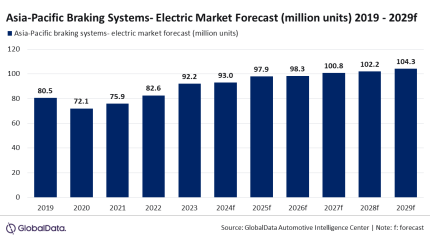
The automotive industry has evolved significantly, especially in braking systems, enhancing comfort, safety, and technological integration. In the Asia-Pacific region, the adoption of cutting-edge technologies, such as electric vehicles (EV), is forecast to drive the growth of electrical braking systems market at a compound annual growth rate (CAGR) of 2.3% during 2024-2029, according to GlobalData.
Its latest report, Global Sector Overview & Forecast: Braking Systems – Q2 2024, reveals that the braking systems-electric in APAC is estimated at 93.0 million units in 2024 and is expected to reach 104.3 million units in 2029.

Discover B2B Marketing That Performs
Combine business intelligence and editorial excellence to reach engaged professionals across 36 leading media platforms.
Madhuchhanda Palit, automotive analyst, said: “Improving battery range for EVs has been crucial for increasing adoption rates, with regenerative braking emerging as a key innovation. This technology recovers kinetic energy usually lost as heat during braking, converting it into electricity to recharge the battery, thus extending the vehicle’s range. Regenerative braking is also used in hybrid and internal combustion engine (ICE) cars to cut fuel consumption, reduce exhaust emissions, and meet stringent emission standards. Adoption of this technology is steadily growing.
“On the other hand, specific technologies are gaining popularity and have already formed a market. For example, resistive braking motors are employed in situations where the motor speed surpasses the speed set by the variable frequency drive (VFD) or when quick deceleration is required. These motors can provide controlled braking with enhanced torque, which makes them especially beneficial in electric vehicles.”
The key companies in the automotive sector are actively contributing to innovations to address various concerns. For example, Bosch’s vacuum-independent regenerative braking system “iBooster” reduces brake dust emissions significantly. In ZF’s electro-mechanical brake system, braking force is generated at each wheel by an electric motor without the need for a hydraulic system and brake fluid. This system is designed for shorter braking distances, better recovery of braking energy, and lower maintenance costs.
Palit added: “While the electrical braking systems market is expected to grow at a healthy rate, the foundation braking system, i.e, drum and disc brakes market is expected to decline over the forecast period. This is due to stringent emission regulations, as friction-based systems generate brake dust, a major contributor to non-exhaust emissions, and frequent wear and tear increases maintenance costs. Additionally, the rapid growth of electric and hybrid vehicles is set to boost the electrical braking system market.”






